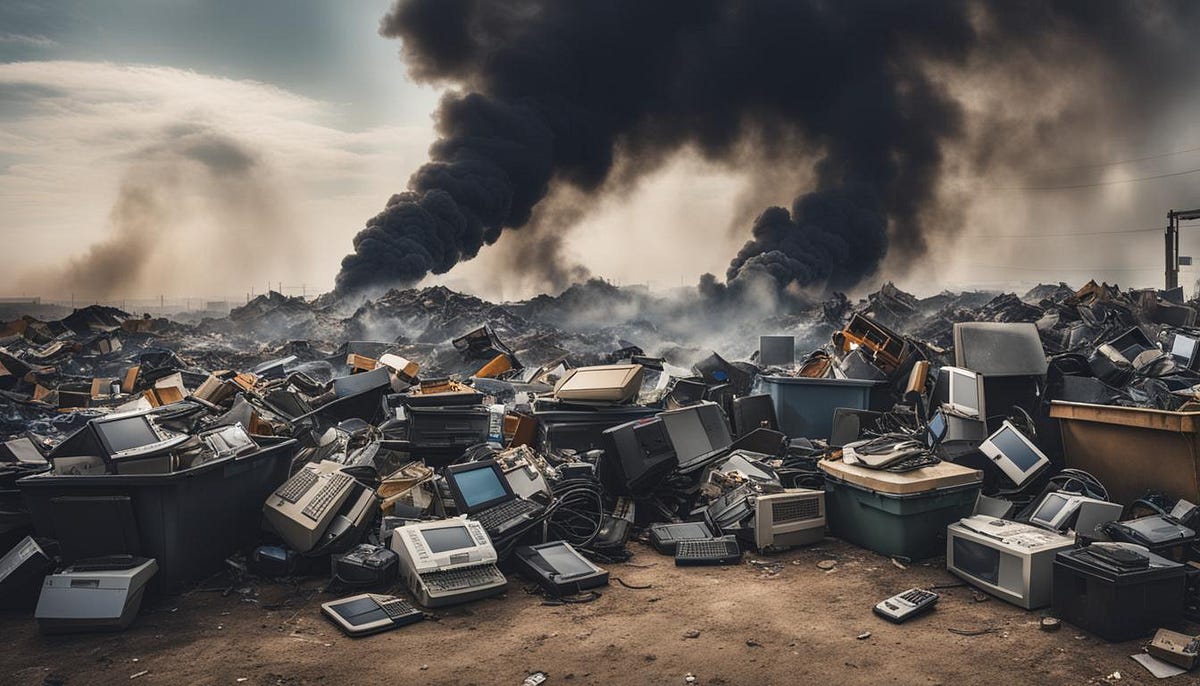Address
1 Woodville Rd, Granville NSW 2142, Australia
Work Hours
Monday to Friday: 9AM - 5PM
Weekend: Saturday - Sunday
Address
1 Woodville Rd, Granville NSW 2142, Australia
Work Hours
Monday to Friday: 9AM - 5PM
Weekend: Saturday - Sunday

Electronic waste, or e-waste, is rapidly becoming one of the most pressing environmental challenges of our time. With the global rise in technology usage, discarded electronics—ranging from smartphones to computers—are accumulating at an alarming rate. The environmental and human impact of e-waste is devastating, as improperly disposed electronics release toxic substances into the environment, posing serious risks to ecosystems and human health. This article explores the negative consequences of e-waste and the urgent need for sustainable recycling practices to mitigate these harmful effects.
E-waste refers to discarded electronic devices that are no longer functional or desired by their owners. These include old smartphones, laptops, televisions, refrigerators, and other electronics. As the digital revolution continues, the rate of e-waste production has skyrocketed, leading to a growing accumulation of toxic materials in landfills and improper recycling facilities.
The environmental impact of e-waste is extensive and long-lasting. Here’s how it affects the planet:
E-waste contains a variety of hazardous substances, including lead, mercury, cadmium, and brominated flame retardants, which can leach into the soil and water when not properly recycled. These toxic chemicals contaminate ecosystems, harming plant and animal life, and ultimately making their way into the food chain. The improper disposal of e-waste in landfills and incinerators exacerbates this issue, releasing harmful fumes into the air and poisoning nearby communities.
When e-waste is dumped in landfills or burned in open-air settings, the toxic materials seep into the soil and water. This can have disastrous consequences for local ecosystems. For instance, heavy metals from e-waste can poison aquatic life, reduce biodiversity, and disrupt natural water cycles, leading to further ecological damage. Freshwater sources can become polluted, affecting both wildlife and human populations that rely on these resources.
While electronic devices themselves may not contribute directly to greenhouse gas emissions, the disposal of e-waste can be a significant source of air pollution. Incinerating e-waste or dumping it in landfills produces harmful gases, including carbon dioxide (CO2) and other greenhouse gases. These emissions contribute to global warming and climate change, intensifying the environmental consequences of e-waste.
Beyond its environmental toll, e-waste poses severe risks to human health, particularly in developing countries where improper recycling practices are common.
In many parts of the world, especially in low-income countries, e-waste is recycled in informal, unregulated settings. Workers, often without proper safety equipment, manually disassemble electronic devices, exposing themselves to toxic substances like lead, mercury, and cadmium. These hazardous chemicals can lead to a variety of health problems, including respiratory issues, skin diseases, neurological damage, and even cancer. Children and pregnant women are particularly vulnerable to these toxins.
In areas where e-waste is improperly disposed of, entire communities suffer the consequences. The release of harmful chemicals into the air, water, and soil can lead to long-term health issues for residents, including respiratory diseases, birth defects, and developmental disorders. Additionally, those living near e-waste dumpsites often experience higher rates of infectious diseases due to contamination of local water supplies.
The informal e-waste recycling sector can also have physical and mental health consequences for workers. The labor-intensive process of dismantling electronics in unsafe conditions leads to physical strain, such as musculoskeletal injuries. The stress of working in an unregulated environment and exposure to toxic substances can contribute to mental health issues like anxiety and depression.
The global e-waste crisis is growing at an alarming rate. According to the Global E-Waste Monitor, around 53.6 million metric tons of e-waste were generated in 2019, and this number is expected to rise to 74.7 million metric tons by 2030. This surge in e-waste is largely driven by the rapid pace of technological innovation and increasing consumer demand for the latest gadgets.
In developed countries, recycling rates for e-waste remain low, with only about 17.4% of e-waste being properly recycled globally. The majority ends up in landfills or is processed in informal recycling operations, especially in regions like Southeast Asia, Sub-Saharan Africa, and parts of Latin America.
To address the environmental and human impact of e-waste, sustainable practices and regulations are needed. Here are some potential solutions:
Advancements in recycling technology can significantly reduce the harmful effects of e-waste. For example, AI-powered robots and advanced shredders can efficiently sort and dismantle electronics, ensuring that toxic components are safely extracted. Hydrometallurgical processes, which use water-based chemicals, are also emerging as an eco-friendly alternative to traditional e-waste recycling methods.
Stronger global regulations on e-waste disposal are essential. Countries can adopt stricter laws to enforce responsible e-waste management, including extended producer responsibility (EPR) programs. Under EPR, manufacturers are held accountable for the entire lifecycle of their products, including their disposal and recycling. This helps reduce the amount of e-waste entering landfills and ensures that electronics are recycled properly.
Educating consumers on the importance of recycling electronics and properly disposing of e-waste is crucial. By increasing public awareness and offering convenient drop-off locations for old electronics, we can encourage responsible recycling and reduce the environmental footprint of discarded devices.
The concept of the circular economy is essential in addressing e-waste. In a circular economy, products are designed with reuse and recycling in mind. By encouraging manufacturers to design electronics that are easier to repair, upgrade, and recycle, we can reduce the amount of waste generated while extending the lifecycle of valuable materials.
The environmental and human impact of e-waste is undeniable and requires immediate action. By embracing sustainable recycling practices, strengthening legislation, and increasing public awareness, we can mitigate the harmful effects of e-waste and protect both the planet and human health. As technology continues to evolve, it’s crucial that we build a more sustainable future for electronics—one that minimizes waste, maximizes resource recovery, and ensures a healthier world for generations to come.